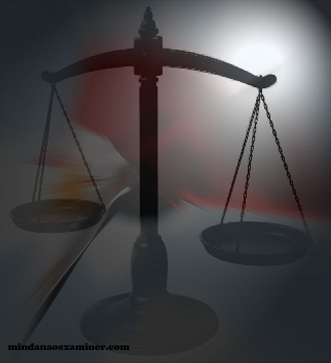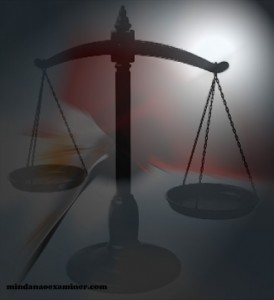
A Proposal by Christianne Mae C. Balili, Jose Gabriel A. Cabaron, Bensaud O. Degusman, Khalil B. Lajarato and Varellie C. Vargas – Xavier University College of Law – Zamboanga.
ZAMBOANGA CITY (Mindanao Examiner / Mar. 23, 2013) – The idea of mistaken identity is commonly found in the plot of various movies – the leading actor is mistakenly identified by the police as that elusive criminal, he gets arrested and tortured, he makes his escape in the most action-packed way possible, and in the end he captures the real criminal who is then made to suffer the sanctions provided by law. This, however, is a far-fetched happy ending for mistaken identity cases.
More than ten years ago, on 20 August 2002, members of the religious group Jehovah’s Witnesses were kidnapped in Patikul, Sulu. Subsequently, a group of twenty individuals were arrested from different areas in Mindanao for allegedly participating in the commission of the said kidnapping. These twenty individuals were alleged to be members of the Abu Sayyaf Group (ASG), a notorious terrorist group operating in the Philippines known for their kidnapping and extortion activities.
The arrestees vehemently denied any involvement in the kidnapping and being members of the ASG, maintaining that they were innocent and mere victims of mistaken identity. They also claimed to be victims of maltreatment by the police officers while under custodial investigation.
Eventually, only three out of the twenty arrestees were positively identified by the witnesses as having participated in the kidnapping. As for the rest of the seventeen, there was not enough evidence to prove their participation, much more their membership in the ASG. It was later found out that they were all arrested by mistake. To make matters worse, it was proven that they suffered physical and psychological abuse in the hands of the police while under custody.
The aforementioned is a clear case of miscarriage of justice. It forms part of the myriad of both solved and unsolved cases of arbitrary arrests and mistaken identity, proof of the bitter truth of the prevalence of injustice in the Philippine “justice system”. This case should clearly expose the existence of gaps and holes in the administration of justice in the Philippines, which gaps and holes are prevalent in the area of servicing of warrants of arrest and conducting custodial investigation.
This paper proposes specific procedures aimed at the reduction, if not total elimination, of cases of mistaken identity leading to miscarriage of justice in the servicing of warrants and conducting of custodial investigations. These recommend procedures are: (1) improvements in the arrest procedures; and (2) creation of a real-time centralized database.
IMPROVEMENTS IN THE ARREST PROCEDURES
Major improvements in the present procedures of arrest being employed by the police force are also recommended.
The current procedures employed in making an arrest start with the filing of a complaint before a judge who decides whether or not to issue a warrant of arrest. The warrant of arrest contains the name and description of the persons to be arrested. Members of the police force then serve the warrant/make the arrest. Most of the time, the person arrested is presented to the public through press releases and press conferences.
The current procedures as outlined above involve areas which are susceptible to abuse constituting violation of due process and other infringement of the basic human rights of the arrestee, and result to miscarriage of justice.
The first area of flaw is the filing of the complaint which serves as basis for the issuance of the warrant of arrest by the judge. In cases involving kidnapping and other heinous crimes, for obvious reasons, the complaints are not filed by the victims themselves. A complainant other than the victim gives a verbal testimony to the police officer, and the latter prepared a written complaint based on the verbal testimony.
The complainant then affixes his signature on the complaint. Such a method may soil the integrity of the complaint because the police officer can fabricate the contents of the written complaint for his convenience and personal interest.
He can even force the complainant to sign the fabricated complaint against the latter’s will and hide the fabrication from the judge. This flaw in the process can be cured by requiring oral statements rather than written complaints to be presented to the judge.
This will greatly improve the credibility and accuracy of information received by the judge, which will be the basis for deciding whether to issue the warrant of arrest or not. The increase in the time and effort required in making the oral statements will certainly be immaterial when compared to the improved credibility and accuracy of the information/complaint.
The second flaw is the person of the arresting officer. More often than not, police officers conduct their arrests alone or in a group without being accompanied by an independent witness. This gives the police officers the opportunity to make arrests according to their own discretion and identify the arrestee based solely on their own understanding of the information in the warrant. This unbridled discretion is even more pronounced when the warrants of arrest ambiguous, vague or too general. Some ill-minded police officers may use such flaw to further their own interests and ulterior motives. Arbitrary arrests of innocent citizens may also be done for mere publicity’s sake.
To cure such defect, it is highly recommended that the arresting officer be accompanied by representatives of the Department of Justice, the Commission on Human Rights, and if possible, the witness or complainant. The representatives of the Department of Justice and the Commission on Human Rights shall ensure that the procedures employed for the arrest are in accordance with that set forth in law and that the rights of the accused during the whole process are protected. The witness or complainant should ensure the proper identification of the arrestee.
Another notable flaw is the publicizing of arrests through the media. This publicity naturally tends to give a sense of credit and glory to the arresting officers. While recognition of the efforts of police officers is not in itself bad, it may tend to unduly move them to make shortcuts in the process to be able to make as many arrests as they can; hence, violating due process and the basic human rights of the arrestee. Such public exposure to the media should be controlled, if not at all avoided. Every accused is presumed innocent until proven guilty. Arrestees should not be subjected to public ridicule.
CREATION OF DATABASE
Two centralized, real-time databases should be created and maintained: one for the accused and suspects, and the other for informants and agents of the peace force. The importance of this is emphasized in the cases of alleged terrorists who are at large.
The first database for accused and suspects shall contain a list of all known terrorists groups and their affiliates. It shall include information such as the name, family background, educational background, associations, etc., and identification pictures of known terrorists – both arrested and at large in the national and international front.
Every arrest made on account of alleged terrorism will be entered into the database, such update being real-time. The database will be maintained by the Chief of Police of every precinct and be regularly checked by representatives from the Department of National Defense and the Department of Justice. Such database will also be made available and accessible for regular inspection by representatives of the Commission on Human Rights.
Maintenance and operation of such a database is for the purpose of ensuring that information regarding terrorists is updated and well-maintained. This will ensure that only those who are identified as the proper subject of warrants are arrested, and the innocent shall remain free from any arbitrary arrest. For example, information is received regarding an individual, X, who has a name identical to that of an identified terrorist.
The arresting officer will check the database to confirm the identification of the individual. If it matches the identification of the individual as provided in the database, then the latter shall be arrest. Otherwise, the arrest procedures will be held in abeyance and the identity of the individual will have to be rechecked. Eventually, the warrant of arrest will be cancelled when it is proven that such is a case of mistaken identity.
Another purpose of the database is to provide information to the arresting officer on the identities of the terrorists in the locality and nearby places. This is helpful as terrorists are known to be transferring from one place to another. the police force to ensure an efficient and effective administration of justice.
CONCLUSION
No justice system is perfect. At the time being, the Philippine justice system may be in an imperfect state. However, neither is it in a terminal state. The Philippine justice system is evolving and progressing towards becoming a better and improved system of protection, not only of the public and the victims, but equally of the arrestees and the accused.
As the English jurist William Blackstone in his seminal work, Commentaries on the Laws of England, say, “It is better that ten guilty persons escape than that one innocent suffer”1. With this principle in mind, we strongly believe that the improvements in the arrest proceedings and the creation of real-time centralized databases, as discussed in the foregoing, will greatly help pave the way towards that envisioned society of justice. Through the continuous support and teamwork of the officials and members of the police force, the Executive Branch, the Legislative Branch, the Judicial Branch of the Government and the public at large, such a major transformation in the justice system is not impossible and far-fetched.

